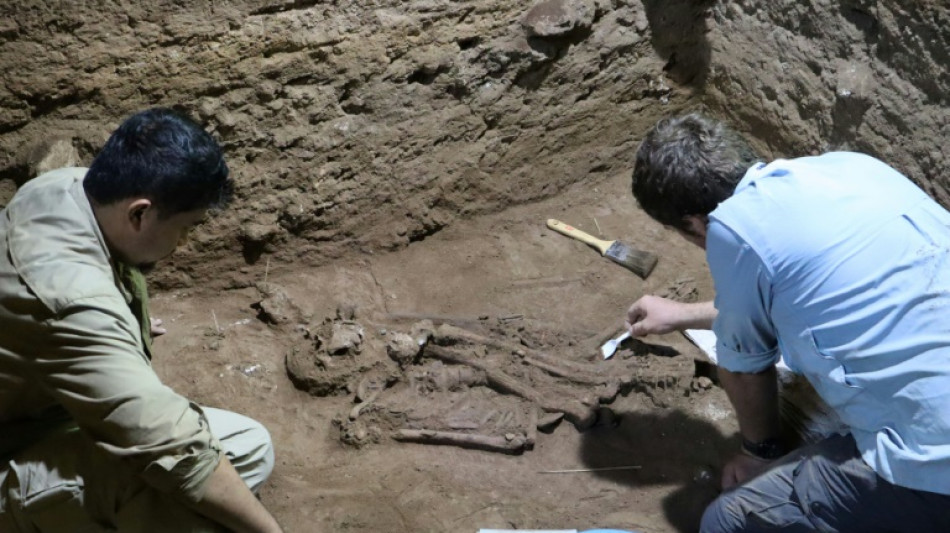
-
 Israel hits Gaza and Lebanon in deadly strikes
Israel hits Gaza and Lebanon in deadly strikes
-
Power cuts as Russian missiles pound Ukraine's energy grid

-
 Denmark's Victoria Kjaer Theilvig crowned Miss Universe 2024
Denmark's Victoria Kjaer Theilvig crowned Miss Universe 2024
-
Dutch police use hologram to try and decode sex worker's murder

-
 Israel bombs south Beirut after Hezbollah targets Haifa area
Israel bombs south Beirut after Hezbollah targets Haifa area
-
Biden in historic Amazon trip as Trump return sparks climate fears

-
 India hails 'historic' hypersonic missile test flight
India hails 'historic' hypersonic missile test flight
-
Israel orders Beirut residents to flee after Hezbollah targets Haifa area

-
 Davis, LeBron power Lakers over Pelicans as Celtics win in OT
Davis, LeBron power Lakers over Pelicans as Celtics win in OT
-
Trump and allies return to New York for UFC fights

-
 Hong Kong political freedoms in spotlight during bumper trial week
Hong Kong political freedoms in spotlight during bumper trial week
-
Debt-saddled Laos struggles to tame rampant inflation

-
 Senna, Schumacher... Beganovic? Macau GP showcases future F1 stars
Senna, Schumacher... Beganovic? Macau GP showcases future F1 stars
-
India's vinyl revival finds its groove

-
 G20 tests Brazil's clout in Lula 3.0 era
G20 tests Brazil's clout in Lula 3.0 era
-
Over 20,000 displaced by gang violence in Haiti: UN agency

-
 Famed gymastics coach Bela Karolyi dies
Famed gymastics coach Bela Karolyi dies
-
'Break taboos': Josep Borrell wraps up time as EU's top diplomat

-
 Climate finance can be hard sell, says aide to banks and PMs
Climate finance can be hard sell, says aide to banks and PMs
-
Trump revives 'peace through strength,' but meaning up to debate

-
 New York auction records expected for a Magritte... and a banana
New York auction records expected for a Magritte... and a banana
-
Egypt's middle class cuts costs as IMF-backed reforms take hold

-
 Beirut businesses struggle to stay afloat under Israeli raids
Beirut businesses struggle to stay afloat under Israeli raids
-
Dupont lauds France 'pragmatism' in tight New Zealand win

-
 Swiatek leads Poland into maiden BJK Cup semi-final
Swiatek leads Poland into maiden BJK Cup semi-final
-
Trump taps fracking magnate and climate skeptic as energy chief

-
 West Indies restore pride with high-scoring win over England
West Indies restore pride with high-scoring win over England
-
Hull clings to one-shot lead over Korda, Zhang at LPGA Annika

-
 Xi tells Biden ready for 'smooth transition' to Trump
Xi tells Biden ready for 'smooth transition' to Trump
-
Trump nominates fracking magnate and climate skeptic as energy secretary

-
 Tyson says 'no regrets' over loss for fighting 'one last time'
Tyson says 'no regrets' over loss for fighting 'one last time'
-
Springboks' Erasmus hails 'special' Kolbe after England try double

-
 France edge out New Zealand in Test thriller
France edge out New Zealand in Test thriller
-
Xi tells Biden will seek 'smooth transition' in US-China ties

-
 Netherlands into Nations League quarter-finals as Germany hit seven
Netherlands into Nations League quarter-finals as Germany hit seven
-
Venezuela to free 225 detained in post-election unrest: source

-
 Late Guirassy goal boosts Guinea in AFCON qualifying
Late Guirassy goal boosts Guinea in AFCON qualifying
-
Biden arrives for final talks with Xi as Trump return looms

-
 Dominant Sinner cruises into ATP Finals title decider with Fritz
Dominant Sinner cruises into ATP Finals title decider with Fritz
-
Dinosaur skeleton fetches 6 million euros in Paris sale

-
 Netherlands-Hungary Nations League match interrupted by medical emergency
Netherlands-Hungary Nations League match interrupted by medical emergency
-
Kolbe double as South Africa condemn England to fifth successive defeat

-
 Kolbe at the double as South Africa condemn England to fresh defeat
Kolbe at the double as South Africa condemn England to fresh defeat
-
Kolbe at the double as South Africa beat England 29-20

-
 'If I don't feel ready, I won't play singles,' says Nadal ahead of Davis Cup farewell
'If I don't feel ready, I won't play singles,' says Nadal ahead of Davis Cup farewell
-
Fifth of dengue cases due to climate change: researchers

-
 Trump's Republican allies tread lightly on Paris pact at COP29
Trump's Republican allies tread lightly on Paris pact at COP29
-
Graham equals record as nine-try Scotland see off tenacious Portugal

-
 Protesters hold pro-Palestinian march in Rio ahead of G20
Protesters hold pro-Palestinian march in Rio ahead of G20
-
Graham equals record as nine-try Scotland see off dogged Portugal


Ancient skeleton reveals amputation surgery 31,000 years ago
A skeleton discovered in a remote corner of Borneo rewrites the history of ancient medicine and proves amputation surgery was successfully carried out about 31,000 years ago, scientists said Wednesday.
Previously, the earliest known amputation involved a 7,000-year-old skeleton found in France, and experts believed such operations only emerged in settled agricultural societies.
The finding also suggests that Stone Age hunter-gatherers living in what is now Indonesia's East Kalimantan province had sophisticated medical knowledge of anatomy and wound treatment.
"It rewrites our understanding of the development of this medical knowledge," said Tim Maloney, a research fellow at Australia's Griffith University, who led the work.
The skeleton was uncovered in 2020 in the imposing Liang Tebo cave known for its wall paintings dating back 40,000 years.
Surrounded by bats, terns and swiftlets, and interrupted by the occasional scorpion, scientists painstakingly removed sediment to reveal an astoundingly well-preserved skeleton.
It was missing just one notable feature: its left ankle and foot.
The base of the remaining leg bone had a surprising shape, with knobbly regrowth over an apparently clean break, strongly indicating that the ankle and foot were removed deliberately.
"It's very neat and oblique, you can actually see the surface and shape of the incision through the bone," Maloney told a press briefing.
Other explanations, like an animal attack, crushing injury, or fall, would have created bone fractures and healing different from those seen in the skeleton's leg.
A tooth and surrounding sediment showed the skeleton is at least 31,000 years old and belongs to a person who died at around 20 years old.
Despite the incredible trauma of amputation, they appear to have survived six to nine years after the operation, based on the regrowth on the leg bone, and suffered no major post-operative infection.
That suggests "detailed knowledge of limb anatomy and muscular and vascular systems," the research team wrote in a paper published Wednesday in the journal Nature.
"Intensive post-operative nursing and care would have been vital... the wound would have regularly been cleaned, dressed and disinfected."
- 'A hotspot of human evolution' -
Humans have been operating on each other for centuries, pulling teeth and drilling skull holes in a process called trepanation.
But amputation is so complex that in the West it only became an operation people could reasonably hope to survive about a century ago.
The oldest previous example was a 7,000-year-old skeleton with a forearm found in France in 2010.
It appeared to confirm that humans only developed sophisticated surgery after settling in agricultural societies, freed from the daily grind of hunting food.
But the Borneo find demonstrates hunter-gatherers could also navigate the challenges of surgery, and did so at least 24,000 years earlier than once thought.
For all that the skeleton reveals, many questions remain: how was the amputation carried out and why? What was used for pain or to prevent infection? Was this operation rare or a more common practice?
The team speculates that a surgeon might have used a lithic blade, whittled from stone, and the community could have accessed rainforest plants with medicinal properties.
The study "provides us with a view of the implementation of care and treatment in the distant past," wrote Charlotte Ann Roberts, an archeologist at Durham University, who was not involved in the research.
It "challenges the perception that provision of care was not a consideration in prehistoric times," she wrote in a review in Nature.
Further excavation is expected next year at Liang Tebo, with the hope of learning more about the people who lived there.
"This is really a hotspot of human evolution and archeology," said Renaud Joannes-Boyau, an associate professor at Southern Cross University who helped date the skeleton.
"It's certainly getting warmer and warmer, and the conditions are really aligned to have more amazing discoveries in the future."
A.O.Scott--AT


